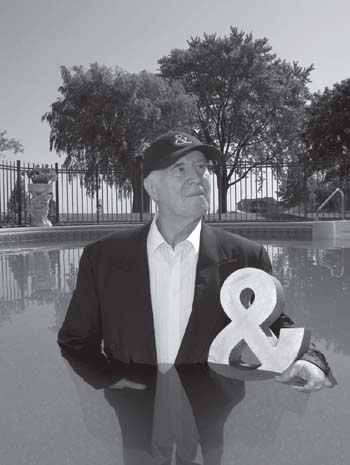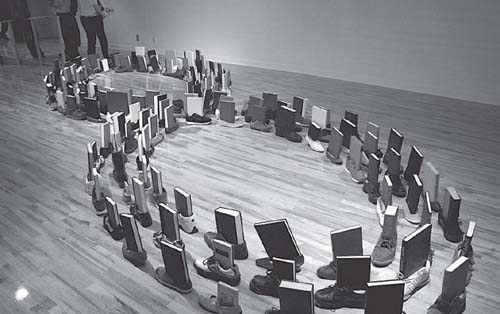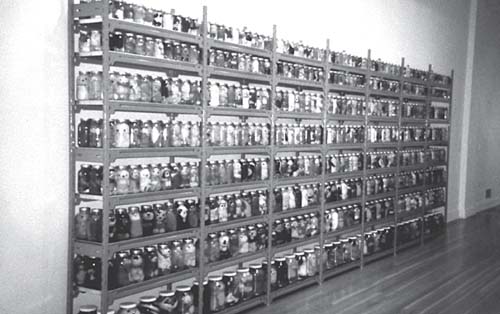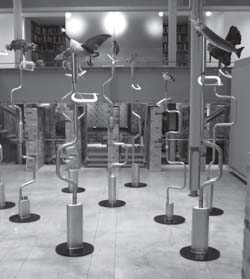feature:
Don’t Forget the Ampersand
IAIN BAXTER& has been making conceptual art for 45 years. David Silverberg talks to the artist about the mysteries of what comes next
The first thing you notice about IAIN BAXTER& is his name. All caps, ampersand anchoring the surname. It’s unusual, but BAXTER& doesn’t like conformity. One of Canada’s best known conceptual artists, the 73-year-old Windsor, Ontario resident doesn’t think along the same brain-paths as 99.9% of the population. He’s too busy dreaming up courageous challenges to our assumptions of art.
Take his most recent remounting. During the all-night artfest Nuit Blanche, in the heart of Toronto’s financial district, BAXTER& restaged his take on capitalism, Monopoly with Real Money. It’s exactly as it sounds-people play the board game Monopoly with real Canadian cash. A camera mounted above the board projects the action for passers-by to check out. So what’s the point?
“It’s designed to make us think about money more concretely,” BAXTER& says in a phone interview. Because of Wall Street doldrums and Ponzi schemes, he wants the fiscally responsible to truly understand the value of the cash they’re throwing around, even if they’re simply buying Park Place in Monopoly.
This conceptual art project may be familiar to anyone who attended York University in the ’70s-BAXTER& mounted this piece in 1973 when he was teaching art at York, even winning the sponsorship of TD Canada Trust (and a temporary loan of their cash).
The Nuit Blanche curator, Jim Drobnick, who commissioned BAXTER&’s Monopoly project, views the artist’s exhibit as timely and instructional. “In our hyperventilated economy, a new dose of reality is sinking in,” he says. “And Monopoly with Real Money can reveal a lot about the players.” Especially when those players are notable names such as k-os, former MuchMusic VJ Hannah Sung, poet/radio host Jemeni and Broken Pencil’s own Hal Niedzviecki.
It would be glib to merely highlight BAXTER&’s latest work, considering the 45 years he’s spent constructing conceptual art out of the ideas that ignite his imagination. To the artist, it’s all about three words, he says: wonder, play, love. “If you include all of those, you’re living a good life,” he says.
A survey of his celebrated projects highlights the significance of those three words in his artwork. In Still Life, BAXTER& “preserves” stuffed animals in large white jars, as if they are specimens to be catalogued by the next cyborg generation. Here the artist gives us a playful reminder of how these toys represent endangered animals deserving our careful consideration. The environmental theme makes sense, especially when you learn how BAXTER& thought about going into zoology before conceptual art beckoned him to an even wilder calling.
Techno Compost sounds simplistic at first-a chain link fence surrounding a graveyard of old computers, printers and other electronic junk-but he staged it in 1996, before we had the convenience to dump our chemical-laden laptops in a safe spot. Always conscious of our consumerist zealousness, BAXTER& invited people to add to the installation by throwing out their own gadgets. He urges us to play with his ideas. He wants us to wonder how we can add another layer to a piece of art that should be anything but static.
Then there’s Zero Emissions, BAXTER&’s cheeky jab at pollution. Last April in Toronto’s Distillery District, taxidermied animals were impaled on upright mufflers. The muffler ends were pinched off, as if the turkeys and coyotes were sacrificed from our dependency on the car. “What is the car and what does it do?” BAXTER& tends to question, extending that curiosity to everything surrounding him.
He tends to follow Marshall McLuhan’s theories on articulating the information overload drowning out our understanding of the world. Coupled with his love of Zen Buddhism, BAXTER& has spent decades trying to look at art from different angles in order to question everything around him. “I want to take a moment to think about a thought I have, to be more conscious about how I live,” he notes.
Checking out BAXTER&’s six-page resume, it’s apparent his way of thinking is resonating with art lovers worldwide. His collections have been exhibited in Canada, the US, Holland, France, Switzerland and Korea. In 2004, he won the Governor General’s Award in Visual and Media Art. He is an Officer of the Order of Canada and has received the Order of Ontario, and honorary doctorates from UBC and the University of Windsor. He has taught visual art in many provinces, and is now rooted in Windsor as a professor emeritus at U of W.
Torontonians will be able to check out his array of work when the Art Gallery of Ontario mounts a BAXTER& retrospective in early 2011. Curator David Moos says of the artist: “He’s been very influential in the contemporary art scene, and not just in Canada. In fact, his contribution is almost difficult to assess because of the diversity of his pieces.”
Blame the faux-company BAXTER& founded in 1966, the N.E Thing Co., giving him the freedom to unleash a variety of artwork on an amused public. It could be a road-trip video 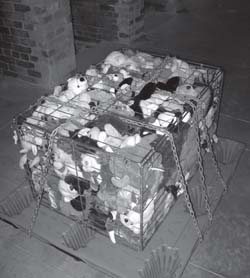 offering 100 hours of footage, all filmed from the windshield of a car. Or maybe he tips his hat to Ray Bradbury’s Fahrenheit 451 by arranging three parallel rows of shoes to form an infinity symbol, each shoe holding a book. There are those three words again: the wonder of peeking behind the veil, the play of daring design, the love of literature.
offering 100 hours of footage, all filmed from the windshield of a car. Or maybe he tips his hat to Ray Bradbury’s Fahrenheit 451 by arranging three parallel rows of shoes to form an infinity symbol, each shoe holding a book. There are those three words again: the wonder of peeking behind the veil, the play of daring design, the love of literature.
BAXTER& admits the Internet has influenced him to tinker with projects spiced with a digital leaning. Currently, he’s working on a project involving identity on the Web, that’s all he’s saying for now. But he’s happy to explain another mystery-why the legal name change?
“The ampersand, the word ‘and,’ is all about the mystery of what comes next,” he says. A fitting footnote for an artist who continues to chip away at the truth.

